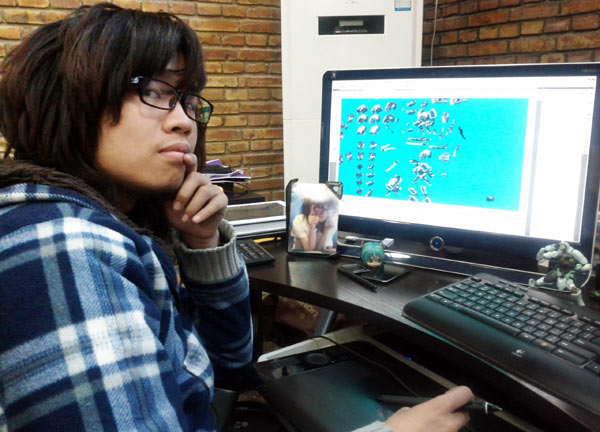In the game
By Eric Jou (China Daily) Updated: 2014-01-23 08:23
|
 Artistic Director Mu Fei breaks down the animation of an on screen game character into different movement blocks. [Photo / Provided to China Daily]
|
 |
| Violinist to ski at Sochi |
 |
But before long, Zhou decided that gaming was where he wanted to be after all, and he reconnected with Mu. The duo decided to take what they loved about video games and make something that they would enjoy. The result was their first game, Crystalides.
"We went with a sci-fi theme. I preferred sci-fi - I didn't want to do what everyone else was doing, martial-arts fantasies and the like," says Mu. They rounded out their team by hiring a programmer and a musician - the latter turned out to be a childhood friend of Mu.
As Crystalides progressed, the little-known duo failed to get media attention for the project despite winning independent developer awards. During this time, Zhou was still working full time in Canada.
When the opportunity for C-Wars came about, Zhou had quit his job in Canada to pursue the game-development dream. Mu also devoted his time to working on C-Wars.
Both young men grew up in Beijing playing video games. Zhou was a PC gamer, recalling such games as Tapper and QBert, whereas Mu was a console gamer whose favorite game as a child was Super Mario Bros.
Their passion and history playing video games led to the art direction for Crystalides, and the selling point to their new game C-Wars. Work on Crystalides had progressed to a point where the game was playable, so Onipunks picked out the best part of the game and expanded on it. They used and extrapolated on a retro pixel-art style, where each image is made up of blocks built upon blocks.
Learning from the problems of Cyrstalides, Zhou turned to a site that was exploding online, KickStarter.com. That popular crowd-sourcing website allows developers, inventors and the like to circumvent traditional forms of fund-raising in favor of asking the masses for money.
- China suspends ban on foreign video game console sales
- Chinese-made video games appeal to international players
- Exercise video games fail to improve fitness
- Online game hits back at official corruption
- Alibaba enters mobile game arena after seeing rivals gain
- Nintendo shares surge as China eases gaming console ban
- NHTSA says finds no 'defect trend' in Tesla Model S sedans
- WTO rare earth ruling is unfair
- Amway says 2014 China sales may grow 8%
- President Xi in Europe: Forging deals, boosting business
- CNOOC releases 2013 sustainability report
- Local production by Chery Jaguar Land Rover this year
- Car lovers test their need for speed in BMW Mission 3
- China stocks close mixed Monday

















